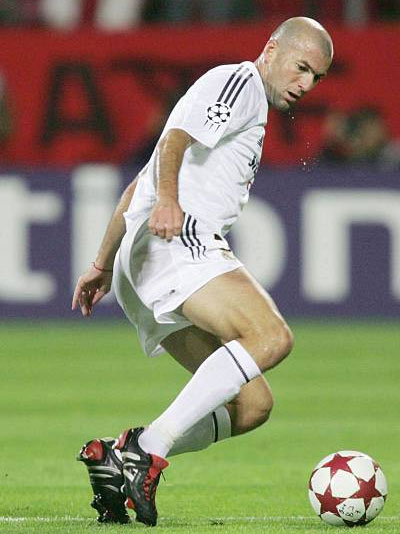♣ Cruyff turn
The Cruyff turn is an evasive dribbling move used in football, and named after Dutch player Johan Cruyff.
In the 24th minute of the game against Sweden in the group stage of the 1974 World Cup, while Cruyff had control of the ball in an attacking position but was facing his own goal and being guarded tightly by Swedish defender Jan Olsson, Cruyff feigned a pass before dragging the ball behind his standing leg, turning 180 degrees, and accelerating away. With its simplicity, effectiveness and unpredictability, the Cruyff turn remains one of the most commonly recognized dribbling moves in modern football.
The fact that the feint was named after Cruyff, however, does not mean that Cruyff was the first to perform this move. Just like with most evasive dribbles, feints and tricks, the first footballer to perform it, is almost always impossible to trace down. Pele, for example, performed the trick in 1960 (vs Juventus).
▲ Johan Cruyff Netherlands professional footballer
♣ Marseille turn
The Marseille turn, also known as the 360, the Spin, the Mooresy Roulette, the Roulette, the Girosflin, and the double drag-back, is a specialised dribbling skill unique to the game of Association football. With so many different names, the exact origin of this skill move is unknown. The Marseille turn was first popularized in Europe by French striker Yves Mariot in the 1970s. Diego Maradona and Zinedine Zidane were arguably the most notable exponents of the move, and thus it has also been known as the Maradona turn and the Zidane turn.
Variations
French footballer Zinedine Zidane was known to use different variations of the Marseille turn. Instead of using his sole to drag the ball back in the move's first phase, Zidane sometimes used the inside of the foot, especially when performing the move while running at high speed.
The possible merits of this variation can be derived from the difference between stud-less training shoes and football boots with studs.The studs of football boots provide less contact area with the ball when compared to a stud-less shoe, thereby increasing the possibility of the move being unsuccessful.
Franck Ribéry and Aiden McGeady have also performed slightly modified versions of the spin. The modifications include dragging the ball behind their standing foot instead of to the side during the first phase, while in the third phase the outside of the boot is used instead of the sole.
The Aiden McGeady variation, known as the McGeady spin, has been included in EA Sports' FIFA video game series.
▲ Zinedine Zidane French professional footballer
Uses and effectiveness
The maneuver is most effective when the opposing player approaches head on or from the side of the player's master foot.
The first drag back enables the player to retain control of the ball by removing the ball from the arc of the opposing player's tackle. The body spin positions the back of the dribbling player's body in between the opposing player and the ball to shield the ball.
The second drag-back changes the direction of the ball, and, when combined with the completion of the spin, allows for both player and ball to move in the same direction and hence gain momentum for a continued run or a shot.
When performed at speed, the maneuver is almost impossible to defend against as it incorporates a sudden change in direction with a continuous shielding of the ball. One tactic the defending player can call upon is to use his body to shove the dribbler off balance during the move. This may invite a foul called upon the defending player, depending on the referee's judgement. The reason players like Zidane and Maradona have been able to use it with a high success rate is due in no small part to their own considerable body mass, as well as their excellent balance.
The maneuver can also be used when the ball is going out of play away from the player. By using a lunging step for the first drag-back in the roulette, the player can prevent the ball from exiting the field of play and continue dribbling along the touchline in one fluid motion.
♣ Seal dribble
A seal dribble is a form of dribbling in association football. It is performed by flicking the ball up from the ground onto the head, whereby the player then proceeds to run past opponents, whilst bouncing the ball on top of his forehead, imitating a seal. The seal dribble makes it very hard for the defending team to challenge legally.
Kerlon, a retired footballer who last played for Slovak side Spartak Trnava in 2017, is historically the most prolific user of this move.
The Italian forward Marco Nappi was also known to use the seal dribble. His most famous use of this move came in the first leg of the semi-final of the 1989–90 UEFA Cup, against Werder Bremen; during the match, Nappi picked up the ball in his area and ran 40 metres with the ball bouncing along his forehead along the right flank.
▲ Marco Nappi Italian professional footballer
Legality
Performing a seal dribble in a game is legally dubious under the 2019–20 version of the Laws Of The Game. Law 12 which covers fouls, defines "playing in a dangerous manner" as any action that threatens injury including to the player themselves, by preventing an opponent from playing the ball due to fear of injury.
As a seal dribble keeps the ball up in the air and close to the player dribbling, only challenges involving an opponent trying to head the ball away and a goalkeeper grabbing the ball or punching it can possibly be legal. Both of these have a clear risk of injury to the players involved. Kerlon's career was marked by incidents where opposition players elbowed, tripped, kicked or headbutted him while he was performing a seal dribble, frustrated by an inability to challenge the seal dribble. A famous case was when Atletico Mineiro's Coelho fouled Kerlon after he performed the seal dribble with a hard elbow attack to the face. As a result, Coelho was initially banned for 120 days although this was reduced to five games after an appeal.
A referee can decide to award a free kick to the opposition should a player attempt a seal dribble in a manner that risks injury, and can caution the seal dribbler for unsporting behaviour for showing a lack of respect for the game.
♣ Flip flap (association football)
The flip flap (also known as the elástico, akka, snakebite, and la culebrita) is a dribbling move, or feint, in football used to trick a defensive player into thinking the offensive player, in possession of the ball, is going to move in a direction they do not intend to. Players perform it by using the outside of their dominant foot to push the ball towards their dominant side, then quickly move the dominant foot around the ball and using the inside to push the ball to their non-dominant side. Although the footwork is the most distinctive aspect of the flip-flap, its success as a feint also relies heavily on the attacking player having an explosive acceleration from a stationary position.
History
The move was invented by the Brazilian-Japanese football player Sérgio Echigo. In 1964, Brazilian playmaker Rivellino learned the move from Echigo, who was his Corinthians teammate in the youth team, and performed it to a global audience during the 1970 FIFA World Cup. In an interview on the television series Football's Greatest in 2012, Rivellino stated "He [Echigo] says now that he invented it, but I perfected it". Pelé, Rivellino's national teammate, was never able to learn the move.
Rivellino was an idol to a number of players, and the trick was popularized early 1980s by Algerian Salah Assad (who developed his own flip flap, which he called "El Ghorraf", and which was executed while running with the ball, unlike Rivelino's), and also Peruvian Julio César Uribe; late 1990s and 2000s by high-profile players such as Romário, Ronaldo and Ronaldinho among others. In recent years, Portuguese footballer Cristiano Ronaldo and Brazilian footballer Neymar have also been known proponents of the move.
In Africa, especially Nigeria, the move has been referred to as a "Snakebite" or "Zigima" because of the in-and-out feet movement of the perpetrator. However, it is now more commonly called "The Gaúcho" – after Ronaldinho (Gaúcho).
In futsal, freestyle and street football, an aerial variation of the flip flap moves has been referred to as a "Akka". The "Akka" has several variations, and can be used in combos with pannas and other ground moves for doling out maximum punishment.
♣ Step over
The step over (also known as the pedalada, the denílson, or the scissors, or the roeder shuffle) is a dribbling move, or feint, in association football, used to fool a defensive player into thinking the offensive player, in possession of the ball, is going to move in a direction they do not intend to move in.
According to one source, the move was invented by Argentine striker Pedro Calomino in the early 1900s, and was first used in Europe by Dutch player Law Adam, who was famous for it in the late 1920s/early 1930s, which earned him the nickname "Adam the Scissorsman". It was later also used in Italy by Amedeo Biavati in the 1930s and was used by former Newcastle United player Glenn Roeder in the 1980s. The step over was popularised in the mid-1990s by Brazilian footballer and global superstar Ronaldo. Nowadays, the technique is in widespread use by attacking players all over the world, such as Cristiano Ronaldo and Neymar.
 Premier League
Premier League La Liga
La Liga Bundesliga
Bundesliga Serie A
Serie A Ligue 1
Ligue 1 Liga Portugal
Liga Portugal Eredivisie
Eredivisie Süper Lig
Süper Lig MLS
MLS Série A
Série A J1 League
J1 League Saudi Pro League
Saudi Pro League WSL
WSL Première Ligue
Première Ligue NWSL
NWSL







 Chapter 13. football (Soccer) tactics and skills > Dribbling advanced (Cruyff turn, Marseille turn, Seal dribble, Flip flap, Step over,.)
Chapter 13. football (Soccer) tactics and skills > Dribbling advanced (Cruyff turn, Marseille turn, Seal dribble, Flip flap, Step over,.)


 •Wikipedia
•Wikipedia








